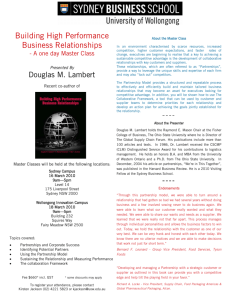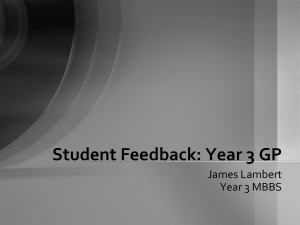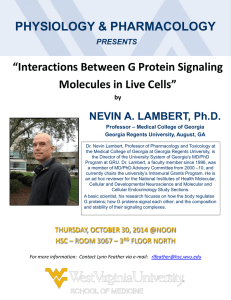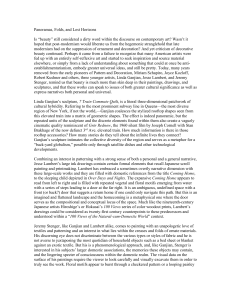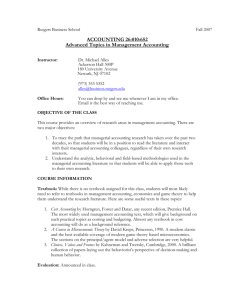Meinong and the Principle of Independence. Its Place in Meinong's... Significance in Contemporary Philosophical Logic by Karel Lambert
advertisement
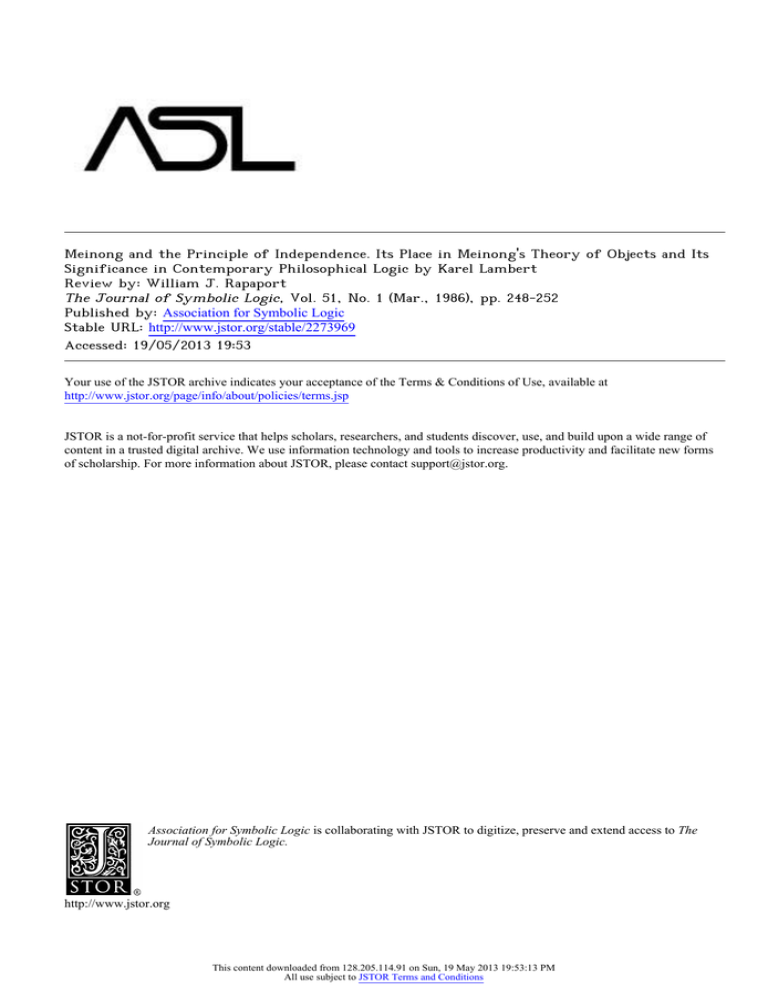
Meinong and the Principle of Independence. Its Place in Meinong's Theory of Objects and Its
Significance in Contemporary Philosophical Logic by Karel Lambert
Review by: William J. Rapaport
The Journal of Symbolic Logic, Vol. 51, No. 1 (Mar., 1986), pp. 248-252
Published by: Association for Symbolic Logic
Stable URL: http://www.jstor.org/stable/2273969 .
Accessed: 19/05/2013 19:53
Your use of the JSTOR archive indicates your acceptance of the Terms & Conditions of Use, available at .
http://www.jstor.org/page/info/about/policies/terms.jsp
.
JSTOR is a not-for-profit service that helps scholars, researchers, and students discover, use, and build upon a wide range of
content in a trusted digital archive. We use information technology and tools to increase productivity and facilitate new forms
of scholarship. For more information about JSTOR, please contact support@jstor.org.
.
Association for Symbolic Logic is collaborating with JSTOR to digitize, preserve and extend access to The
Journal of Symbolic Logic.
http://www.jstor.org
This content downloaded from 128.205.114.91 on Sun, 19 May 2013 19:53:13 PM
All use subject to JSTOR Terms and Conditions
248
REVIEWS
the appropriate basis for Meinongian theories. Zalta's choice of underlying logic has unsatisfactory
consequences for his account of mathematical discourse. (See pp. 147-149.) If, as is standardly assumed,
all true mathematical propositions are necessary, and if, as Zalta assumes, Peano number theory is closed
under strict implication, then, on Zalta's view, for every sentence A of arithmetic, either A holds,
according to Peano number theory, or else - A does. This is an unsatisfactory result for variants of
Peano number theory based on axiomatizable underlying logics. My criticism here clearly applies
to Zalta's axiomatized type theory, and also, I think, to the model theory which he gives for his type
theory.
(e) General remarks. Given the prior availability of excellent work in this tradition by Parsons, Routley,
William Rapaport, and Hector Castaffeda, this book would have benefited greatly from an attempt to
explore carefully its interrelationships with, and divergences from, the previous literature. It would also
have benefited from a sensitive examination of its own presuppositions, such as those mentioned under
headings (c) and (d). Taken by itself, the book does go some way, as the author hoped, toward showing
that non-naive variants of the theory of objects constitute a fruitful area for study. But taken as an
addition to the literature alluded to above, it does not, in my judgment, significantly extend our
MICHAEL BYRD
understanding of the resources or applications of Meinongian theories.
KAREL LAMBERT. Meinong and the principle of independence.Its place in Meinong 's theory of objects
and its significance in contemporaryphilosophical logic. Modern European philosophy. Cambridge
University Press, Cambridge etc. 1983, xvi + 175 pp.
Karel Lambert is well known in the field of philosophical logic, especially in connection with free
logics. It is therefore welcome to see his name added to those who find value in Alexius Meinong's muchmaligned Theory of Objects. In this interesting and valuable contribution to the literature, Lambert
points out the implications of one major thesis of Meinong's theory-the principle of independence
(PI)-for theories of predication and free logics. He discusses the importance of Meinong's theory for
understanding recent analytic philosophy, formulates a version of PI, discusses several theories of
predication, analyzes three types of free logic and their relationships to PI, and provides a defense of his
formulation of PI.
Recent Meinong-inspired theories have tended to fall into two broad categories: (I) those that
distinguish between two kinds of properties, usually called "nuclear"and "extranuclear"(e.g. Terence
Parsons, Nonexistent objects, XLIX 652; Richard Routley, Exploring Meinong's jungle and beyond,
Australian National University, Canberra, 1980), and (II) those that distinguish between two modes of
predication, often called "internal" and "external" (e.g. Hector-Neri Castaffeda, Thinking and the
structureof the world,Philosophia,vol.4 (1974), pp. 3-40; William J. Rapaport, Meinongian theoriesand a
Russellian paradox, Noks, vol. 12 (1978), pp. 153-80). Although Lambert does not develop a full
Meinongian theory, his analysis falls into category (I). The thrust of this review will be to examine
Lambert's analysis in the light of the two-modes-of-predication approach.
In Chapter 1, Lambert presents five reasons why Meinong's views are relevant to contemporary
philosophy: (1) There is our general need to talk and think about non-existents, and Meinong's theory
offers a way to deal with this fact. (2) Meinong is a "natural philosophical adversary"to Quine, because
"Quine's conception of existence is essentially Meinong's conception of being" (p. 5), yet whereas Quine
would affirm that {x:x is an object} = {x:x is an existent}, Meinong would deny it; and where Quine's
slogan is "to be is to be the value of a variable,"Meinong's is "thereare objects of which it is true that there
are not such objects."(3) Meinong's notion of an objective (the object of psychological acts such as belief
or judgment) is the G. E. Moore-Bertrand Russell notion of a singular proposition, a notion needed for
the semantics of quantified modal logic. (4) Meinong's beingless objects can help us understand (and in
some cases are required merely to express) such diverse philosophical theories as those of virtual classes
or of F. H. Bradley's absolute idealism. (5) Meinong's PI can help us understand free logic.
To these may be added a sixth: The recent trend in certain branches of artificial intelligence towards
theories of intensional entities can best be understood in terms of Meinongian theories (cf. William A.
Woods, What's in a link: foundations for semantic networks, in Representation and understanding,
Academic Press, 1975, pp. 35-82; Ronald J. Brachman, What's in a concept: structuralfoundations for
semantic networks,Internationaljournalof man-machinestudies, vol. 9 (1977), pp. 127-152; Anthony S.
Maida and Stuart C. Shapiro, Intensionalconcepts in propositionalsemantic networks,Cognitive science,
vol. 6 (1982), pp. 291-330).
This content downloaded from 128.205.114.91 on Sun, 19 May 2013 19:53:13 PM
All use subject to JSTOR Terms and Conditions
REVIEWS
249
In Chapter 2, Lambert presents his outline of Meinong's theory and his formulation of PI. The first
Meinongian thesis is that "there are objects having no being," where 'there are' must be given "some
appropriate sense" (p. 14). That sense is provided by the next thesis: "The domain of nonbeings Meinong
called 'Aussersein', literally the domain of objects outside of being" (p. 14); i.e., the quantifier in the first
thesis ranges over Aussersein. PI is closely related to Meinong's reason for believing in Aussersein, namely,
"what an object is is a function solely of its nature .... That an object is what it is need not depend on, or
even concern, its being" (p. 17). It should be noted that these two -statements by Lambert are not
equivalent without an assumption to the effect that an object is what it is (i.e., an assumption about the
relationship of "structural" to "assertional" information; cf. Woods, op. cit.). Routley, op. cit., p. 253ff.,
makes this explicit, as does Lambert, several pages later (p. 28). PI, in (my translation of) Meinong's
words, is "the Sosein of an object is not, so to say, concerned with [mitbetroffen] its Nichtsein"; Lambert
formulates this more precisely, as we shall see.
A third Meinongian thesis is the principle of indifference, which "declares that the being or nonbeing of
an object is not part of the nature of that object" (p. 19). An alternative interpretation of this, however, is
that being is not predicable of (thing-like) objecta, but only of (proposition-like) objectives (cf. Rapaport,
op. cit.). Lambert observes that PI and the principle of indifference are distinct: the former says, roughly,
that what an object is is independent of its being; the latter says, roughly, that whether an object is is not
part of what it is. Note that it follows that if "existence" is part of what an object is (e.g. as in the case of the
existing golden mountain), then that "existence" is not that object's being. An object's Sosein is its
"nature"; for Lambert, it is the object's nuclear properties. Its extranuclear properties are those, such as
existence, that are "indifferent" to its Sosein: Lambert, unlike Parsons (op. cit.), derives the notion of
extranuclear properties from the principle of indifference. He gives an example: Being simple (S), which
holds of all and only those objects with just one property, is extranuclear. For suppose o is S because o is
(only) F; then if S were part of o's nature, o would have two properties. It does not necessarily follow,
however, that S and F are distinct kinds of properties, since some object o' might be S because it is (only) S
(just as o was only F). What might be the case, instead, is that o has properties in two ways: o is-internally
(only) F and (hence) is-externally S. Note that if o is-internally S also, then it is not the case that o isexternally S. Object o' is-internally (only) S and (hence) is-externally S.
A further Meinongian thesis discussed by Lambert is this: "if an object has being, it is completely
determined" (p. 26). But, if 'o exists' is taken to mean that there is a real object correlated with the
Meinongian object o (cf. Rapaport, op. cit.), then completeness is neither a necessary condition for
existence, nor is incompleteness a sufficient condition for non-existence: The round square and the golden
mountain do not exist, not because they are incomplete, but because the former is impossible and the
latter just does not happen to. But the tallest mountain, which is just as incomplete, surely does exist.
Let us now turn to Lambert's formulation of PI. It is ingenious and provides him with a fine analytical
tool. It is also arguably as good as many other formulations. But it has some problems. To see why, note
that it is surprisingly difficult to formulate Meinong's loose statement of PI in a precise fashion without
falling into mere tautology. For example, Chisholm tells us that it asserts that "every object ... has the
characteristics it does have whether or not it has any kind of being" (Beyond being and nonbeing,
Philosophical studies, vol. 24 (1973), p. 246. With quantifiers ranging over the domain of Aussersein, this
becomes (PI. 1) Vx [x has Sosein -a. (x has Sein -. x has Sosein) & (x lacks Sein -. x has Sosein)], which is
mere tautology. The somewhat weaker (PI.2) Vx [x has Sein -. x has Sosein) & (x lacks Sein -. x has
Sosein)] is equivalent to Vx[x has Sosein], which, while true, does not carry the message of PI. Consider
next, one version offered by Routley (op. cit., p. 24): (PI.3) Vxi [x has Sosein -. x has Sein]. Now, if the
'a' of (PI.3) is material implication, then this is equivalent to (PI.4) Vx[x has Sosein&x lacks Sein], which
is clearly false. Worse, if we now consider (PI.5) Vxn EJ[x has Sosein -. x has Sein] (or even a version
using relevant implication), then (PI.5) is equivalent to (PI.6) m 3x El[x has Sosein -. x has Sein], i.e., no
(Meinongian) object necessarily exists. Now, Meinong did assert this in at least one place (Uber emotional
Presentation, 1917, see page 95 in the Kalsi translation, On emotional presentation, Northwestern
University Press, 1972), but it is questionable whether he actually meant it. In any event, it would be
somewhat dogmatic to employ a formulation of PI that automatically ruled out ontological arguments.
Note, also, that another equivalent of (PI.5), namely, (PI.7) Vx ' [x has Sosein & x lacks Sein] materially
implies (in as weak a modal system as Kr) Vx < [x lacks Sein], which is as questionable as (PI.6). We might,
then, try (PI.8) 3x 0 [x has Sosein & x lacks Sein]. But then we ought to come right out and assert (PI.9)
3x[x has Sosein & x lacks Sein]. Before being so bold, however, we should also consider (PI.10) * 3x[x
This content downloaded from 128.205.114.91 on Sun, 19 May 2013 19:53:13 PM
All use subject to JSTOR Terms and Conditions
250
REVIEWS
has Sosein & x lacks Sein], which also seems acceptable. And J. Michael Dunn (personal communication)
suggests (PI.11) m EJVx [x has Sosein -+ x has Sein] with '--' as relevant entailment, noting that if ''
were strict implication, this would collapse to (PI.10).
It seems best, however, to avoid unnecessary complications. A reasonable solution, then, is this version,
also due to Chisholm (op. cit., p. 246), "though every object may correctly be said to be something or
other, it is not the case that every object by correctly be said to be": (PI.*) Vx[x has Sosein] &iVx[x
has
Sein]. Note that (PI.*) implies (PI.9), which in turn implies (PI. 10). Moreover, each conjunct of (PI.*) is an
independently acceptable Meinongian thesis.
Lambert's formulation is this (p. 28): (PI.L) The argument "There are nuclear properties P1, P2,... such
that the set of P1, P2,... attaches to s; so, s has being" is invalid. We can now see, however, that this
formulation inherits the problems of (PI.5)-(PI.7), and does not seem to have any significant advantages,
qua Meinongian exegesis, over (PI.*). Why, then, does Lambert formulate it thus? Ultimately it is because
of his formulation of the converse of PI in terms of the logical truth of a certain (material) implication (pp.
24-25). One justification he offers for using the notion of logical truth in that context is his earlier
discussion of the distinction between PI and the principle of indifference; yet this earlier discussion does
not warrant the use of logical truth and, hence, does not warrant a stronger formulation than (PI.*).
Another justification is that certain terms ('presupposes,' 'excludes,' 'properly convertible') used by
Meinong and his student Mally in their discussions of PI "suggest" such a "logical relationship" (p. 24). I
suspect, however, that the nature of Aussersein as the realm of everything there is and is not collapses any
distinctions between logical and material relationships. Textual interpretations
aside, however,
Lambert's larger point remains intact: (PI.L) is clearly Meinongian in spirit, if not in letter, and serves him
well in the sequel, as we shall see.
In Chapter 3, Lambert discusses the "traditional" theory of predication, which he identifies by two key
features: a core thesis (CT) and a constraint. (CT) "A statement has the logical form of predication just in
case it consists of an n-place general term joined to n singular terms and is true (or false) according as that
general term is true (or false) of the n-tuple of objects specified by the n singular terms, or of the object
specified by the singular term if n = 1" (pp. 43-44). The constraint is that the argument, "Gs; so, s has
being" is valid (p. 50). This theory is distinguished from the Meinongian theory of predication, "best
reconstructed as simply CT minus the traditional constraint" (pp. 48-49). Note that those Meinongians
who favor two modes of predication can acccept CT by treating 'true (or false) of' as ambiguous between
the two modes. Lambert himself seems to distinguish (p. 49) between two senses of Meinongian
predication: predication as possession and as true-of; note that the former is "structural," while the latter
is "assertional."
Of chief importance is that (PI.L) is equivalent to the denial of the constraint. For comparison, note
that (PI.*) implies, but is not implied by, the denial of the constraint (here understood as Vx[x has Sosein
-. x has Sein]). But Lambert's proof of equivalence assumes the failure of an abstraction principle (A)
(x)(Fx)s iff Fs (read: s is a thing that is F iff s is F). Now, on the two-modes-of-predication
view, there are
two versions of (A), since 'Fs' is ambiguous; in both versions, to be a thing that is F is to be-internally F:
(Al) s is-internally F iff s is-internally F. (A2) s is-internally F iff s is-externally F. Clearly, (Al) is true, but
uninteresting, while (A2) is false. (Both of Lambert's counterexamples
to (A) turn out, on reinterpretation, to be examples of (A2).) But it is the (A2)-interpretation that is crucial in Lambert's proof.
For, when that proof is re-interpreted in two-modes fashion, the move from (A) and (22') 'The spheroid
which is-internally such that it is not a spheroid is-internally spherical and is-internally such that it is not
a spheroid' to (24') 'The spheroid which is-internally such that it is not a spheroid is-internally spherical
and it is not the case that it is-externally spherical' fails. Moreover, Lambert's (24) construed as (24') is no
longer a contradiction, so (22'), (24'), and (A) do not imply (25') 'The spheroid which is-internally such
that it is not a spheroid has being,' thus blocking Lambert's proof that the constraint implies (PI.L) (just
as it does not imply (PI.*), either).
Next, Lambert identifies three "basic beliefs" (p. 59) that, together, apparently lead to violation of the
law of non-contradiction: (1) CT; (2) that 'so and so' is true of the designatum of 'the so and so'; and (3)
that every singular term refers. Which should be given up? Given the six motivations for Meinongian
theories from our discussion of Chapter 1, (1) seems the most obvious, and is, in fact, Lambert's choice,
since he opts for a modified version, CT, in Chapter 4.
This modified core thesis is a counterfactual version of Quine's theory of predication as stated on p. 168
of Word and object: (CT) "Predication joins an n-place general term to n singular terms to form a
This content downloaded from 128.205.114.91 on Sun, 19 May 2013 19:53:13 PM
All use subject to JSTOR Terms and Conditions
REVIEWS
251
statement which would be true or false according as the n-place general term is true (or false) of the n-tuple
of objects referred to by the n singular terms were they to refer" (pp. 82-83). The point is that CT provides
a syntactic definition of predication that holds even when a singular term fails in fact to refer.
Lambert argues that "CT is nonextensional [in the sense that] there are coextensive general terms ...
such that substitution of one for the other in some statements ... changes the truth-value of those
statements" (p. 84). His argument reveals, however, the need for several crucial assumptions, at least one
of which is not explicit; and even then it is open to objection. Suppose T is a theory for which CT holds;
suppose T contains the irreferential singular term 'the spheroid which is such that it is not a spheroid'-I
consider
take it that this may be understood as 'the x such that x is spherical and x is non-spherical'-and
the general term 'object,' which is true of exactly the universe of objects. For convenience, I shall
abbreviate the irreferential term by 's'. Now, since s is irreferential, it does not "specify" an object.
Consider the statement 's is an object.' This is not true, but-by
CT-it is a predication. Next, the general
terms 'spherical object' and 'spherical if an object' are coextensive, since they are true (or false) of all
spherical (or non-spherical) objects. Lambert then claims that no matter what the truth value, if any, of (*)
s is spherical,' substitution of co-extensive predicates for 'spherical' fails to preserve truth value:
Case i: Suppose (*) is true. Substitution yields 's is a spherical object,' which is false, since s is not an
object. But 'spherical' is co-extensive with 'spherical object' only if there are no non-existent objects,
which was not one of Lambert's original assumptions. (Note, also, that if the substitution is made for all
occurrences of 'spherical,' then 'the x such that x is a spherical object and x is non-spherical is a spherical
object' is still true.)
Case ii: Suppose (*) is false. Substitution yields 's is spherical if an object,' which is materially true, since
s is not an object. But it was not assumed that 'spherical' is co-extensive with 'spherical if an object.' (And
note, again, that complete substitution (as in the first case) yields 'the x such that x is spherical if an object
and x is non-spherical is spherical if an object,' which has the same truth value as (*).)
Case iii: Suppose (*) is truth-valueless. Then substitution as in the first case yields the same results, and
falls prey to the same objections.
Thus, Lambert's claim that "any theory of predication having CT as its core is ... nonextensional"
(p. 93, my italics) is perhaps too strong, since a two-modes theory with non-existent objects could be
extensional.
Chapter 5 presents an excellent overview of free logics and discusses Meinong's role: Meinong has in
common with some free logicians a belief in PI, but, unlike all free logicians, Meinong quantifies over
non-existents. (But why shouldn't free logicians who recognize an outer domain of virtual objects
"quantify" over them with the Meinongian Aussersein quantifier? Promoting virtuality to some sort of
reality seems a virtue in analyses of thought and talk of non-existents.) Lambert classifies free logicians as
"negative" (those who count all simple statements with irreferential singular terms as false), "positive"
(those who count some such statements as true), and "neuter" (those who count all such statements as
truth-valueless). Meinongians are clearly akin to the positive free logicians and not to the negative ones.
Indeed, Lambert shows that PI is inconsistent with negative free logic but entailed by positive free logic.
Furthermore, since the differences between free logics depend on the underlying theories of predication,
and these in turn differ on the acceptability of the traditional constraint, and the constraint is entailed by
PI, it follows that support for (positive) free logic comes from support for PI.
Note, however, that it is crucial to Lambert's thesis that PI not imply "a world of nonbeings" (p. 121),
because "no free logician shares Meinong's world picture" (p. 122). Since (PI.*) does imply that there are
Seinlos objects, I find it preferable to say that either positive free logic is the most plausible free logic or
(better) a Meinongian theory is even more plausible.
Lambert's defense of PI, in Chapter 6, takes the form of exhibiting true sentences about non-beings and
defending their truth. Here, I shall only describe three of these. First, "the winged horse of Bellerophon is
the winged horse of Bellerophon" is clearly about a non-being, and is true because (a) everything the
winged horse of Bellerophon possesses is possessed by the winged horse of Bellerophon (and vice versa)
and also (b) 'the winged horse of Bellerophon' refers to whatever 'the winged horse of Bellerophon' refers
to. Second, the predication "Vulcan is the planet causing the perturbations in Mercury's orbit" is about a
non-being and is true by the definition of 'Vulcan' as 'the planet causing the perturbations in Mercury's
orbit.' Finally, "the winged horse of Bellerophon is mythological" is about a non-being, is clearly true,
and is indeed a predication (since there is no good non-predicational paraphrase of it, e.g. in terms of an
"In the myth ..." operator).
This content downloaded from 128.205.114.91 on Sun, 19 May 2013 19:53:13 PM
All use subject to JSTOR Terms and Conditions
252
REVIEWS
It is to be noted that Lambert's three examples concern a self-identity statement, a definition, and an
extranuclear (alternatively, an external) predication. It is unfortunate, though consistent with his overall
approach, that he finds the more interesting nuclear (alternatively, internal) predications to be weak
support for PI, on the ground of requiring further assumptions (specifically, CT and the law of noncontradiction). On the two-modes approach, however, such a defense is perfectly natural: 'The round
square is round' is true because the property of being round is internally predicable of the round square,
yet the round square lacks being because it is an impossible object. This sort of defense of PI does not
require CT, and it is to be expected that it should require some "independent" principle from the realm of
being (or an empirical fact, as would be needed in the case of 'the golden mountain is golden') in order to
demonstrate non-being.
WILLIAM J. RAPAPORT
DONALD NUTE.
Essentialformalsemantics. Rowman and Littlefield,Totowa, N.J., 1981, xiii + 186
PP.
This unusual textbook, suitable for a second course in logic, is distinguished by its narrowly focused
concern with semantic completeness results for a broad range of logical systems, and by its
unconventional -and unremitting- use of quantificational notation in the meta-language.
Chapter 1 (47 pages) introduces a Zermelo-style set theory (without axioms of choice or infinity) and
mathematical induction. The succeeding four chapters treat, respectively, classical sentential logic (33
pages);first-orderpredicate logic without identity or function letters (40 pages);the modal logics Kr, T, S4
and S5 (23 pages); and three logics of subjunctive conditionals (21 pages). Semantics in which mappings
into {0, 1} play the central role are well if briefly motivated in each case, and developed as far as required
for the presentation of soundness and Henkin-style completeness proofs. But there is virtually no
additional material no mention of alternate (e.g. algebraic)semantics, no discussion of decidability, not
even a statement of the Lowenheim-Skolem theorem.
What material the author has selected, however, is tightly organized and uniformly presented
throughout, so that the semantic refinements necessary for treating modal logic and conditionals are
made to seem inevitable developments, as perhaps they were. There are some pleasant surprises among
the largely standard proofs, for example, an uncomplicated and elegant demonstration of the deduction
theorem wherein the hypothesis that K u {1} H t is used only after showing that {f : K H 0
}
contains K, 0, and the axioms, and is closed under modusponens.
Considerably less elegant is the author's handling of notational matters. At the start, the usual
quantificational
symbols (cI,
, &, v,
-,
(x), (3x), =) are introduced as meta-linguistic
abbreviations,
and such English phrases as "only if," "for every," and "there exist" scarcely occur again in the book.
Blessings are mixed; proofs are quite compact but perspicuity often ends up being sacrificedto excessively
formal rigor. The reviewer would have preferred proofs presented in the style of the journals, this
JOURNAL, and the author's own purported paradigm on page 11,the likes of which are not seen again after
its presentation as a model for students to use as they "develop a mathematical prose style" of their
own.
Object-language symbols and formulas are never displayed. Instead, meta-linguistic names for the
latter are built using prefix notation from a nonstandard set of signs (how many of n, i, u, 1,c does
the reader recall having seen before?). Abbreviations for these names, using infix notation and a more
standard set of symbols (-, I, A, El, >), are introduced immediately, and the author subsequently
switches back and forth at will between these two ways of doing things. Complicating matters further,he
insists that wffs are sequences in the set-theoretic sense-functions from initial strings of positive
integers into sets of symbols, rather than, say, n-tuples. Consequently, the statements of definitions,
theorems and proofs too often become intimidating. To cite but the briefestexample, definition 102 forces
the student to contend with "/ is a modalgeneralizationof - (/ = v (3])((n)(n < {(cr) -+ a. = j) & 4
a**))" when he or she might have been told instead-or at least in addition-that the modal
generalizations of a wff are those obtained by prefixing zero or more necessity signs to it.
Sometimes all this gets to be too much even for the patience of the author who declines, on the grounds
that "the proof is rather long and complicated," to prove a result critical for the many variants of
Lindenbaum's lemma required later-that the set of finite sequences of members of a countable set is
countable. Of course, it is but the work of a few minutes of class time to show how to associate a unique
integer with each such sequence.
Despite these objections, the reviewer liked this book and especially recommends it for those students
This content downloaded from 128.205.114.91 on Sun, 19 May 2013 19:53:13 PM
All use subject to JSTOR Terms and Conditions
